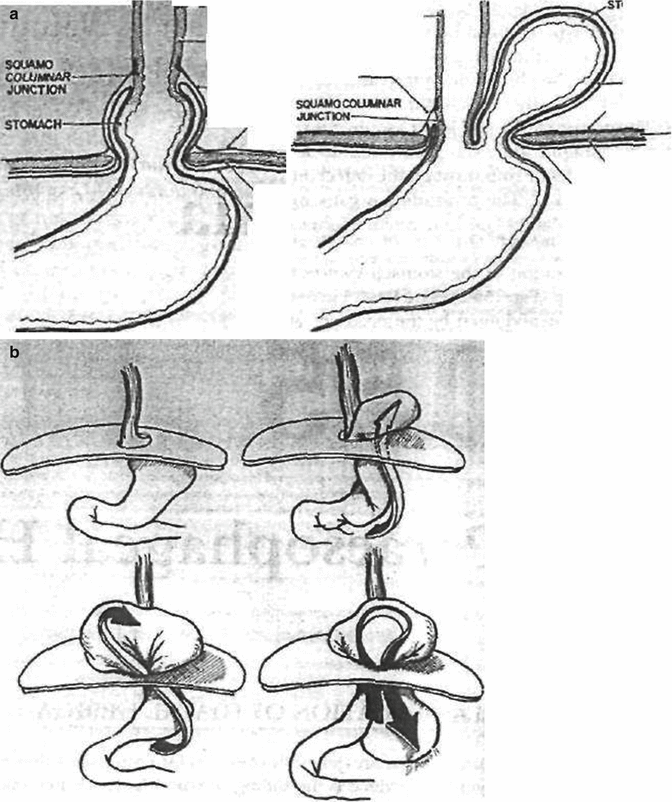Fig. 21.1
Key anatomy of the diaphragm. (a) Diaphragm viewed from the abdomen. Heavy dotted lines show the paths of phrenic nerves. Dark lines show potential incisions which can be made without damaging the phrenic nerves (Thal ER, Friese RS. Traumatic rupture of the diaphragm. In: Fisher JE, editor. Mastery of surgery. 5th ed. Lippincott Williams and Wilkins; 2007). (b) Single-headed arrows show superior and inferior extent of the diaphragm. Two-headed arrow delineated the zone of diaphragmatic traverse (Fotosearch. http://www.fotosearch.com/LIF135/ga141002/)
21.2 Hiatal Hernia
21.2.1 Classification
Hiatal hernia occurs when the esophagogastric junction (EGJ) migrates intrathoracically through the esophageal hiatus. There are four general types of hiatal hernia (Fig. 21.2a). Type I seldom requires emergency management (bleeding), while types II to IV carry the potential for incarceration and strangulation requiring emergency surgical management.


Fig. 21.2
Hiatal hernias and the mechanics of strangulation. (a) Type I sliding hiatal hernia. Type II paraesophageal hiatal hernia. (b) Mechanics of paraesophageal hernia strangulation (Naunheim KS, Edwards M. Paraesophageal hiatal hernia. In: Shields T, Locicero JI, Reed C, Feins RH, editors. General thoracic surgery. 7th ed. Lippincott Williams and Wilkins; 2009)
Type 1 or sliding hernia
Most common type
The EGJ moves upward into the posterior mediastinum.
It is associated with gastroesophageal reflux disease.
Longitudinal axis of stomach is aligned with esophagus.
Type II or paraesophageal hernia
Paraesophageal hernias are uncommon and include a peritoneal layer forming a true hernia sac.
Contributing factors include age and gender (more common in women) and obesity.
The EGJ and cardia remain in the abdomen, while the fundus and greater curvature protrude into the mediastinum.
Type III or mixed hiatal hernia
Has components of both types I and II in that the EGJ is in the chest (as in sliding hernias), and the fundus and greater curve are also herniated.
Type IV hernias are defined by the presence of organs other than the stomach in the chest, which herniate through the esophageal hiatus
Most commonly colon, omentum, or spleen.
Herniation occurs anterior to the esophagus.
21.2.2 Symptoms and Diagnosis
The most feared complications of paraesophageal hernia are incarceration and strangulation. Twisting of the stomach within the hernia sac can result in closed-loop physiology (Fig. 21.2b) which ultimately leads to necrosis, perforation, and death if untreated.
Symptoms
Slow progression of symptoms is usual.
Dysphagia, nausea, vomiting, early satiety, regurgitation, and postprandial chest pain are signs of an intrathoracic herniated stomach.
Anemia can result from chronic ulceration of the gastric mucosa, though hematemesis and melena are rare.
Large hernias may cause pulmonary symptoms such as postprandial breathlessness through compression of the lung.
It is important for the emergency surgeon to recognize whether a significant change in clinical symptoms or systemic signs of sepsis have occurred mandating emergency intervention.
Patients with incarceration usually present in extreme distress.
Chief complaint of chest or epigastric pain.
Nausea with retching and an inability to vomit are typical.
Often a long history of chronic hernia symptoms can be elicited.
Borchardt’s triad of substernal chest pain, retching with inability to vomit, and inability to pass a nasogastric tube is the classic clinical presentation.
If strangulation and necrosis of the intrathoracic stomach has already progressed, patients will present with systemic signs of sepsis and eventually septic shock.
Diagnosis
Chest radiography should be the initial screening imaging modality and frequently shows a retrocardiac air bubble
A barium swallow is diagnostic and an usual part of the elective evaluation of suspected paraesophageal hernia.
Esophagogastroduodenoscopy and 24-h pH monitoring are other components of elective evaluation that are avoided under emergency circumstances.
In the emergency setting, computed tomography (CT) is often more readily available, may confirm the diagnosis, and is useful in the evaluation other potential causes of chest pain.
21.2.3 The Decision to Operate and Surgical Technique
While watchful waiting is acceptable for asymptomatic or minimally symptomatic patients, especially older patients with significant comorbidities, the emergency surgeon should intervene promptly and effectively if complications occur
Several approaches are possible, open transabdominal or thoracic, laparoscopic, or thoracoscopic.
While most general surgeons will be more comfortable with a transabdominal approach, only very experienced laparoscopic surgeons should undertake laparoscopic repair of an incarcerated and possibly strangulated paraesophageal hernia
Operative details
The basic steps are the same for all approaches: (1) reduction of hernia contents, (2) mobilization and resection of the hernia sac, (3) crural closure, and (4) eventually intra-abdominal fixation ± antireflux procedure.
1.
Reduction of the hernia sac’s contents
Exposure of the hiatus is aided by dividing the left triangular ligament and mobilizing segments 2 and 3 of the liver to the right.
While usually straightforward in the elective situation, hernia reduction can be difficult in patients with incarceration causing gastric distension and edema.
Excessive force should be avoided as partial- or full-thickness tears in the already compromised stomach can lead to postoperative leak.
Attempts should be made to guide a nasogastric tube into the dilated stomach to achieve decompression and ease reduction.
Some authors advocate advancing a soft rubber catheter around the viscera into the hernia sac and insufflating air to relieve the vacuum that may be generated when reduction is attempted.
If after these maneuvers the contents of the hernia cannot be easily reduced, a small anterior incision can be made in the hiatus to allow reduction.
2.
Mobilization and resection of the hernia sac
Get Clinical Tree app for offline access

Has never been proven to be necessary but is recommended by most experts because:








